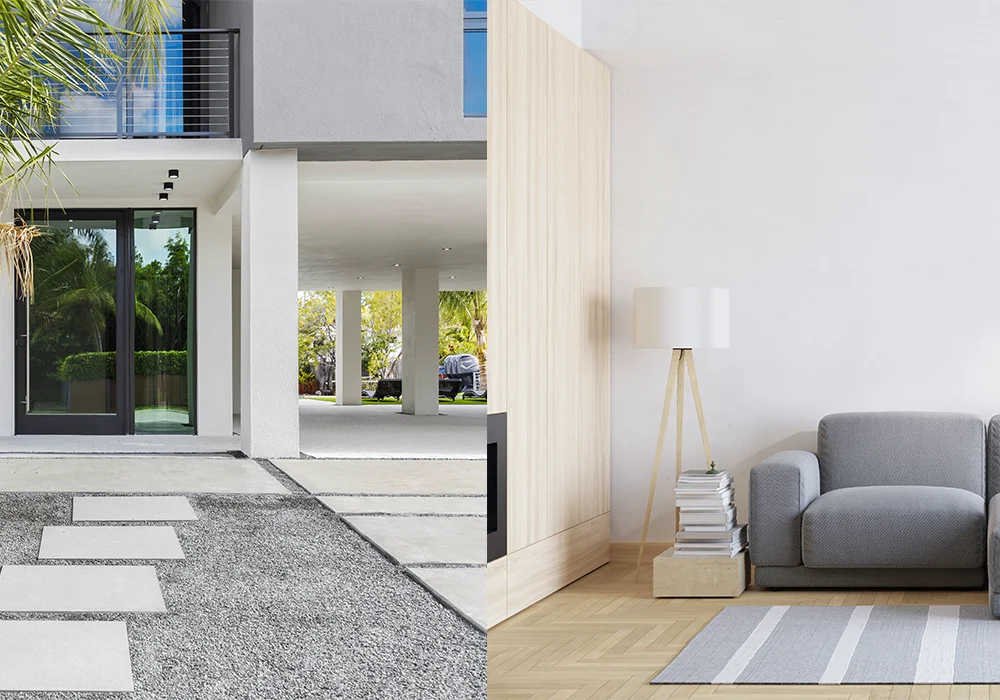Painting a house goes far beyond aesthetics. It serves as a crucial layer of protection and is one of the most effective ways to increase a property’s value, transform spaces, and express style. However, a common question among homeowners is: what are the real differences between interior and exterior painting? And more importantly: what are the ideal materials and precautions for each?
This article aims to clarify these questions, helping you make more informed decisions when it’s time to paint your home — whether inside or out.
What defines interior painting?
Interior painting is directly related to the experience within your living spaces. It influences the feeling of comfort, spaciousness, lighting, and even the emotional well-being of the residents. In addition, because it is done in protected areas, interior painting is less affected by weather conditions, allowing for the use of more delicate materials and a variety of finishes.
The most commonly used paints for indoor spaces are water-based, such as acrylic and latex paints. They offer good coverage, dry quickly, and are easier to clean. The finish options include matte (great for hiding imperfections), satin (more resistant to cleaning with a slight sheen), and semi-gloss (often used in kitchens, bathrooms, and high-traffic areas).
Color choice is also an important factor. Neutral tones tend to convey elegance and make spaces feel larger, while vibrant colors can be used to highlight a wall or add personality to a room.
Another essential point in interior painting is the condition of the walls. In older properties, it’s common to need crack repairs, apply putty or skim coat to ensure a smooth and even surface before applying paint.
What sets exterior painting apart?
Exterior painting, on the other hand, serves both an aesthetic and protective function. It is the first line of defense against external elements such as sun, rain, wind, pollution, and temperature fluctuations. Therefore, the materials used must be more durable, and the painting process should be carried out with greater technical care.
Recommended paints for outdoor areas are specially formulated acrylic paints. They are thicker, moisture-resistant, offer stronger adhesion, and contain antifungal and mildew-resistant properties. It’s also important for them to have UV protection to prevent premature fading.
Moreover, surface preparation for exterior painting is even more demanding. This involves washing the facade, removing built-up dirt (often by power washing), repairing cracks, applying sealant, and in more severe cases, waterproofing exposed walls. These steps ensure the paint adheres properly and lasts longer.
Why shouldn’t the same materials be used for both interior and exterior spaces?
A common mistake is trying to save money by using the same paint throughout the entire house. This approach not only affects the final appearance but may lead to higher costs in the medium term, as the wrong type of paint in the wrong setting loses durability quickly.
For example, interior paint is not resistant to water or sunlight. When used outdoors, it tends to fade, crack, or peel in a short period. Conversely, exterior paint may be too thick for indoor use, often has a stronger odor, dries more slowly, and lacks the refined finish desired in rooms and living spaces.
Each type of paint is designed for a specific purpose, and using it correctly ensures not just beauty, but also cost savings and structural preservation of your home.
What is the role of surface preparation?
Wall preparation is one of the most overlooked steps by those who try to paint on their own. However, it’s this step that determines the overall quality of the job. Whether indoors or outdoors, a poorly prepared wall — with dirt, mold, moisture, or imperfections — hinders paint adhesion and significantly shortens its lifespan.
Indoors, this often involves applying spackle, sanding with fine grit to correct flaws, and leveling the surface using techniques like skim coating. Outdoors, preparation includes pressure washing, crack treatment, sealing, and, when needed, waterproofing.
These steps are crucial and are part of professional painting services — far beyond simply “putting paint on the wall.”
When is it best to hire a professional?
Although painting may seem like a simple task, the final result depends on several technical factors: correct choice of materials, surface preparation, humidity levels, ambient temperature, even and uniform application, among others.
An experienced professional knows how to handle all these aspects, delivering not only a visually pleasing finish but one that is durable and functional as well. Additionally, professional work helps avoid material waste and the need for touch-ups, which translates into long-term savings.
Hiring a painting service also allows you to benefit from the professional’s expertise in recommending the best type of paint, finish, and color according to the specific needs of each space.
Painting your home is more than just an aesthetic step. It is a direct investment in property value, daily comfort, and protection from the elements. Understanding the differences between interior and exterior painting, choosing the right materials, and respecting each phase of the process is key to achieving a long-lasting, high-quality result.
If you’re planning to renovate your home — inside or out — working with a professional team makes all the difference. Contact us for a free, no-obligation estimate. We’d be happy to learn more about your project and help transform your spaces.

